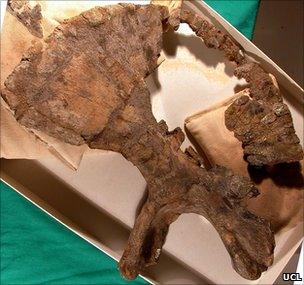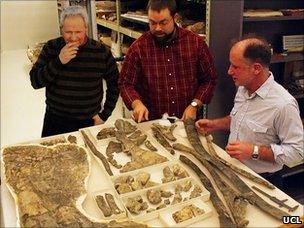Dinosaur named 'thunder-thighs'
- Published
Dr Mike Taylor explains why he thinks Brontomerus had "thunder thighs". All footage courtesy of UCL.
Scientists have named a new dinosaur species "thunder-thighs" because of the huge thigh muscles it would have had.
Fossil remains recovered from a quarry in Utah, US, are fragmentary but enough to tell researchers the creature must have possessed extremely powerful legs.
The new species, described in the journal Acta Palaeontologica Polonica, is a sauropod - the family of dinosaurs famous for their long necks and tails.
It could have given other animals a hefty kick, say its discoverers.
"If predators came after it, it would have been able to boot them out of the way," said Dr Mike Taylor, from University College London, UK.
The team has named its dinosaur Brontomerus mcintoshi - from the Greek "bronto", meaning "thunder"; and "merós", meaning "thigh".
The fossilised bones of two specimens - an adult and a juvenile - have been dated to be about 110 million years old.
They were rescued from the Hotel Mesa Quarry in Grand County, Utah.
The site has been looted by commercial fossil-hunters and so scientists have probably been denied the full range of material from which to make their classification.
Nonetheless, those bones they do have sport tell-tale features that mark out an extraordinary species.
Chief among them is a hip-bone, called the ilium, which is unusually large in comparison to that of similar dinosaurs.

The size and shape of the hip-bone tells scientists about the muscles in the leg
The wide, blade-shaped bone projects forward ahead of the hip socket, providing a proportionally massive area for the attachment of muscles.
"As you put the skeleton together, you can run muscles down from the hip-bone to join at the knee and that gives you a whopping thigh," Dr Taylor told BBC News.
"What's interesting is that if it were a sauropod that could move particularly fast, you would expect to see very strong muscles on the back of the leg to pull it along. But we don't; this is the opposite. It seems most likely to us that what this is about is being able to deliver a strong kick," he told BBC News.
The paleo-scientists speculate that the larger specimen in their possession is the mother of the juvenile.
The adult would have weighed about six tonnes - something like the size of a large modern elephant - and probably measured 14m in length.
The juvenile would have weighed in at about 200kg - the size of a pony - and been 4.5m long.
Brontomerus was living in what geologists term the Early Cretaceous Period.
Some other marks on the fossils give additional clues to what sort of lifestyle the creature had and the environment it faced.
"The shoulder blade of Brontomerus has unusual bumps that probably mark the boundaries of muscle attachments, suggesting that Brontomerus had powerful forelimb muscles as well," explained team-member Dr Matt Wedel, from the Western University of Health Sciences in Pomona, California.

Scientists may be missing many bones, plundered from the quarry site by commercial fossil-hunters
"It's possible that Brontomerus mcintoshi was more athletic than most other sauropods. It is well established that far from being swamp-bound hippo-like animals, sauropods preferred drier, upland areas; so perhaps Brontomerus lived in rough, hilly terrain and the powerful leg muscles were a sort of 'dinosaur four-wheel drive'."
The team also believes the find is significant for its position in Earth history, in that it challenges the notion that sauropods began to disappear in the Early Cretaceous.
"Because sauropods were the most abundant dinosaurs found during the Jurassic Period and the rarest during the Early Cretaceous, there's long been the perception that sauropods were successful in the Jurassic and were replaced by duckbills and horned dinosaurs in the Cretaceous," said Dr Wedel.
"In the past 20 years, however, we are finding more sauropods from the Early Cretaceous period, and the picture is changing. It now seems that sauropods may have been every bit as diverse as they were during the Jurassic, but much less abundant and so much less likely to be found."
Dr Taylor is disappointed that more of Brontomerus could not be recovered, and wonders whether larger fossil pieces are being held in some unknown private collection.
"The fossil-hunters basically pillaged this site," he told BBC News.
"They left behind broken remnants and smashed bits of bone; and in some cases they were using broken bones to hold down tarpaulins - that's really the most disgraceful aspect of it."
- Published13 January 2011
- Published12 November 2010
- Published5 October 2010